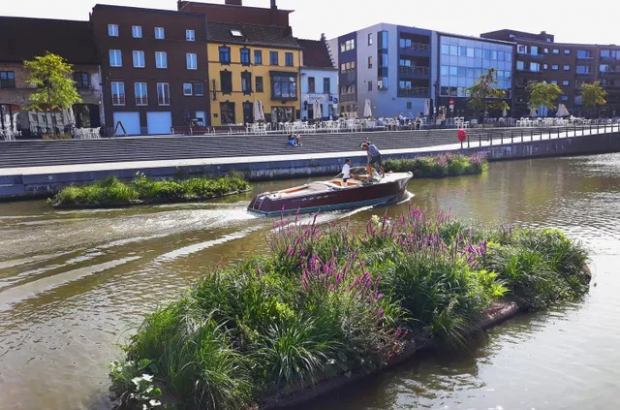- Daily & Weekly newsletters
- Buy & download The Bulletin
- Comment on our articles
Green islands in Brussels Canal by next spring
A pilot project will be rolled out next May that aims to improve biodiversity in the Brussels Canal. Green ‘islands’ will be anchored in the middle of the canal in the area of the Brussels Yacht Club in Laeken.
The island will be fortified with plants and flowers that attract bees and birds and with roots known to help purify water. Cages will be attached underneath the floating islands to hold oyster shells, which will offer protection to some underwater life and a spawning area for fish. The islands will have a surface area of 220 square metres.
The islands are being placed following a feasibility study carried out by the port of Brussels in co-operation with the non-profit organisation Canal it Up, which works to convince politicians to tackle the canal’s dire environmental situation.
Attracting life
“If you look at the canal where it runs through the centre, it’s grey stone walls, vertical,” Pieter Elsen of Canal it Up told The Bulletin earlier this year. “No one can do anything with it. Not humans, not animals, not insects. For this lack of biodiversity and nature, we have worked out a plan to create islands with plants that have root systems that grow 30 or 40 centimetres down into the water. Fish can lay eggs in these roots, they can hide from bigger fish, they can find food there. Birds can use the larger islands as a nesting spot. The plants will attract lots of insects as well. This creates an ecosystem. We would be attracting life to where today there is nothing.”
Similar islands have been established in urban waterways, including in France, the UK and in Kortrijk in West Flanders (pictured above). They have been shown to indeed improve biodiversity and also attract people to watersides they now ignore – or avoid.
The Brussels Yacht Club was chosen to establish the first islands because there are no large stormwater basins nearby, explained Brussels environment minister Alain Maron (Ecolo) and because it is equipped with dolphins – wooden poles to which boats are secured. “The absorb disturbances to the water and are also suitable for attaching floating structures,” Maron told parliament. The banks are also steep and fairly inaccessible here, which reduces the risk of people climbing onto the islands, vandalism and fly tipping.”
 Bridgewater Basin in Manchester, before and after the addition of green islands in 2018 ©Biomatrix Water
Bridgewater Basin in Manchester, before and after the addition of green islands in 2018 ©Biomatrix Water
The islands will be monitored and an assessment made after 12 months. Should they prove to be effective in helping to clean the surrounding water and introducing biodiversity, the project will be extended to other parts of the canal.
“Part of this project involved raising public awareness about the return of biodiversity and greener riverbanks,” said Maron. “Establishing the green islands and the technical and ecological follow-up will be linked to workshops for the public and in schools. Canal it Up will organise that, together with the contractor.”
Photo top: ‘Floating Gardens’ was established in Kortrijk as part of the art parcours Contrei Live, but the islands are now a permanent fixture
©Biomatrix Water


















